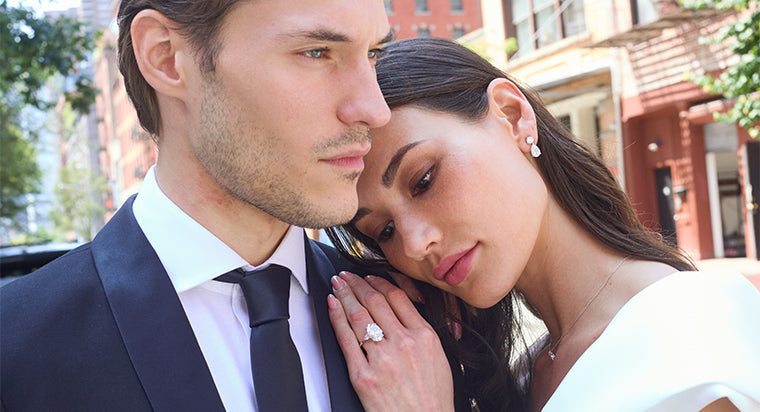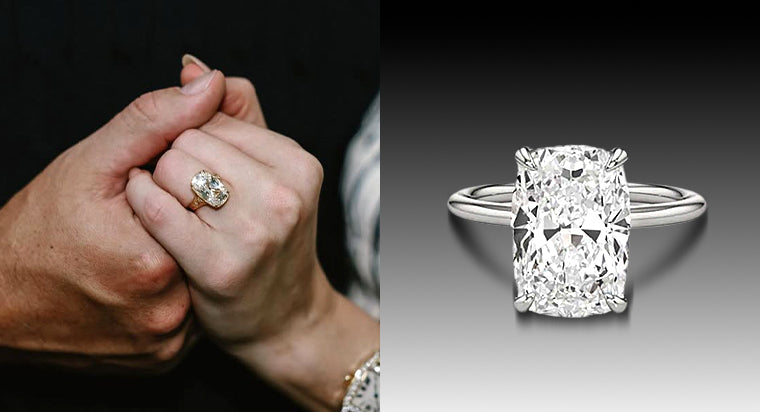History of Engagement Rings

Julius Caesar’s wife, Calpurnia, married Caesar in 59 BCE. French Queen Clotilde married in 493 AD. Mary of Burgundy married in 1477. Queen Victoria of the Victorian Era married in 1840. Elizabeth Taylor married her first husband in 1950. And Angelina Jolie married for the first time in 1996.
What do these woman have in common? Even though these women lived centuries apart, in completely different worlds, all of them wore engagement rings. The origin of engagement rings in the western world is debated. The most reliable evidence traces the history of engagement rings back to ancient Rome. By the second century BCE, the custom in Rome was established: a man proposing to a woman would give her two rings, one gold and one iron. The gold was worn in public as a symbol of wealth, and the iron represented a long-lasting bond, because iron is strong and resilient. These rings also represented the man’s ownership of the woman. That’s not the most romantic notion I’ve ever heard—a more endearing custom from the ancient world involves the “vena amoris,” a vein which, many ancients believed, ran from the left ring finger to the heart. Because of this, we traditionally wear engagement rings on the same left finger today.
Engagement ring history continues into the middle-ages, when these rings became serious, binding contracts. Even before any written proof of marriage, an engagement ring was taken very seriously. These rings were usually bands of metal, possibly engraved. The Renaissance gives us the first recorded use of a diamond engagement ring. Diamonds were rare and expensive, so simpler metal bands persisted. During the enlightenment, posie rings—rings engraved with messages or small images— were especially favored. The tradition of engraving engagement rings dates back to Ancient Rome (see above) and is still common today.
Later, in the Victorian Era, diamonds became more plentiful. Still, only aristocratic and royal men could afford diamond rings. Their popularity rose—the Victorian Era was marked by shows of wealth and splendor, and diamonds in rings added to this tradition among the wealthy. Diamonds got more and more popular until after World War I, moving into the Great Depression. The expense and luxury of diamonds was too much for many people to afford, so after a long run, diamonds fell out of style for younger generations.
Enter jewelry company De Beers Consolidated Mines, Ltd. In the 30’s, the price of diamonds was falling, and jewelry companies were losing money. In 1947, De Beers launched the now-famous ad campaign “diamonds are forever.” Even if you’ve never heard this slogan, you’ve experienced its effects —this campaign managed to sway the public opinion so significantly that through the 50’s and to the present day, around 75% of Americans purchase diamond engagement rings. Diamonds became essential to engagement, and diamond rings began to represent the lasting bonds of marriage.
Today, we still love diamond engagement rings. Celebrities like Elizabeth Taylor and Marilyn Monroe, and more modern Angelina Jolie and Beyoncé, wear diamond engagement rings. Other older styles have made their way to the present, too: the Roman tradition of gold is popular today, along with the tradition of engraving rings with words and small images which spans engagement ring history. From the origin of engagement rings to the modern day—from Calpurnia to Angelina Jolie—styles and trends have changed, but the significance of the ring on that special day has not.
FAQs
Where did engagement rings originate?
Engagement rings originated in ancient Rome around the second century BC. A man proposing to a woman would give her two rings – a gold ring to symbolize wealth and one made from iron to represent a long-lasting bond.
What is the significance of an engagement ring?
An engagement ring represents an upcoming marriage, love and commitment to one another. The circular shape also represents eternity and thus it is a universally accepted symbol of eternal love.
Which gemstone is associated with an engagement ring?
Typically, gemstones like diamonds, sapphires, rubies, and emeralds are some of the most common gems associated with an engagement ring. These precious gems are popular as they look stunning and are highly durable.
What are posie rings?
Posie or posey rings, were prominently used during the 15th through the 17th centuries in France and England. These rings, carved from gold or silver, featured a short inscription or engraving on the surface, which was typically a message of love.









